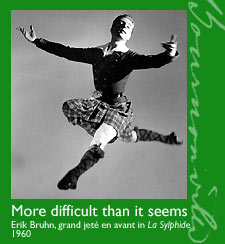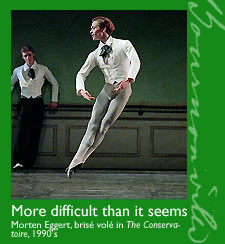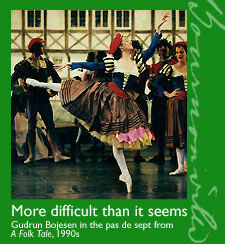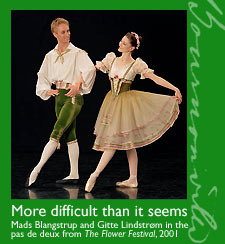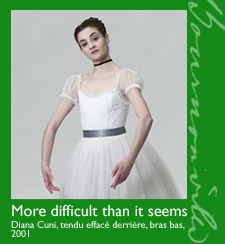|
|
|||||
|
What is so special about the Bournonville style?
|
|||||
|
|
"All too small, all too modest". That?s what tourists in Copenhagen often complain about the statue of the Little Mermaid. In many ways the same arguments count for Bournonville?s choreography. It isn?t flashy, it is almost natural and it doesn?t seem difficult, at least not compared to the famous Russian ballets. Truly, "La Sylphide" might not seem as deadly exhausting as "Swan Lake". However, asking the dancers about the difficulties of dancing Bournonville, one soon discovers that Bournonville?s style is treated with great respect. Dancing Bournonville is just as hard as dancing Petipa or Balanchine. It just demands completely different abilities of the dancer. In other words, the style of Bournonville?s choreography is very special: unartificial grace, combined with talent of understating even the biggest steps, discretion of mime and heavy dramatic impact. Just to put it short. In search of harmony Bournonville dancers both need to be good dancers and good actors. Dancing in itself, without the face so to speak, will never create a convincing Bournonville dancer. On the other hand, there is no such thing as a perfect Bournonville body. Even though many Bournonville dancers have been pretty short, the musicality and dramatic talent of the dancers seem to be the crucial characteristics. Secret épaulement Generally, the épaulement also includes a certain twist of the head and not the least a distinct direction of the eyes, so that the look follows the foot, in order to make the spectator look at the foot as well. The arms are generally rounded, and the fingers are calm and soft. Quick footwork The series of steps often have a floating ease about them. Bournonville never created from-corner-to-corner-choreography. In stead, he let the dancers move forwards and backwards again and again in the same variation, using the complete area of the stage and not caring about the breath of the dancer... Down at the music Furthermore, Bournonville strictly divided his choreography in "mime parts" and "dance parts", dedicating the cheerful music to the dance, believing the dance to be an expression of joy. However, the mime carries some of the same characteristics as the dance; thus Bournonville mime is very clear, simple and almost understated. Style in change Today, the dancers of the Royal Danish Ballet dance many different choreographic styles, not the least that of the neo-classical ballet. As a consequence, it can be hard for the dancers not to show off their brilliant triple turns, their perfect "six o?clock" balances and their looooong arms. However, these expressions look foreign in the Bournonville world and immediately stick out. It is within the frame of the Bournonville style, that the dancers have to challenge themselves. To make their bodies move with the Bournonville grace and charm, without revealing how difficult it is. Anne Middelboe Christensen (born 1964), M.A. Assistant professor of dance history at University of Copenhagen and dance critic at the Danish daily Information and dance correspondent for international magazines such as Dance Magazine and Tanz International. She gladly receives your comments at anne_middelboe_christensen@information.dk
|

